So, is the recession over? The Office for National Statistics’ (ONS) retail sales figures show that sales volumes were flat in February, when many expected them to fall. Moreover, the increase in sales volumes for January was revised upwards from 3.4 per cent to 3.6 per cent, coming on the back of a sharp fall in December (on seasonally-adjusted figures).
Already a subscriber? Log in
Subscribe for just $2 a week
Try a month of The Spectator Australia absolutely free and without commitment. Not only that but – if you choose to continue – you’ll pay just $2 a week for your first year.
- Unlimited access to spectator.com.au and app
- The weekly edition on the Spectator Australia app
- Spectator podcasts and newsletters
- Full access to spectator.co.uk
Or





















Comments
Don't miss out
Join the conversation with other Spectator Australia readers. Subscribe to leave a comment.
SUBSCRIBEAlready a subscriber? Log in